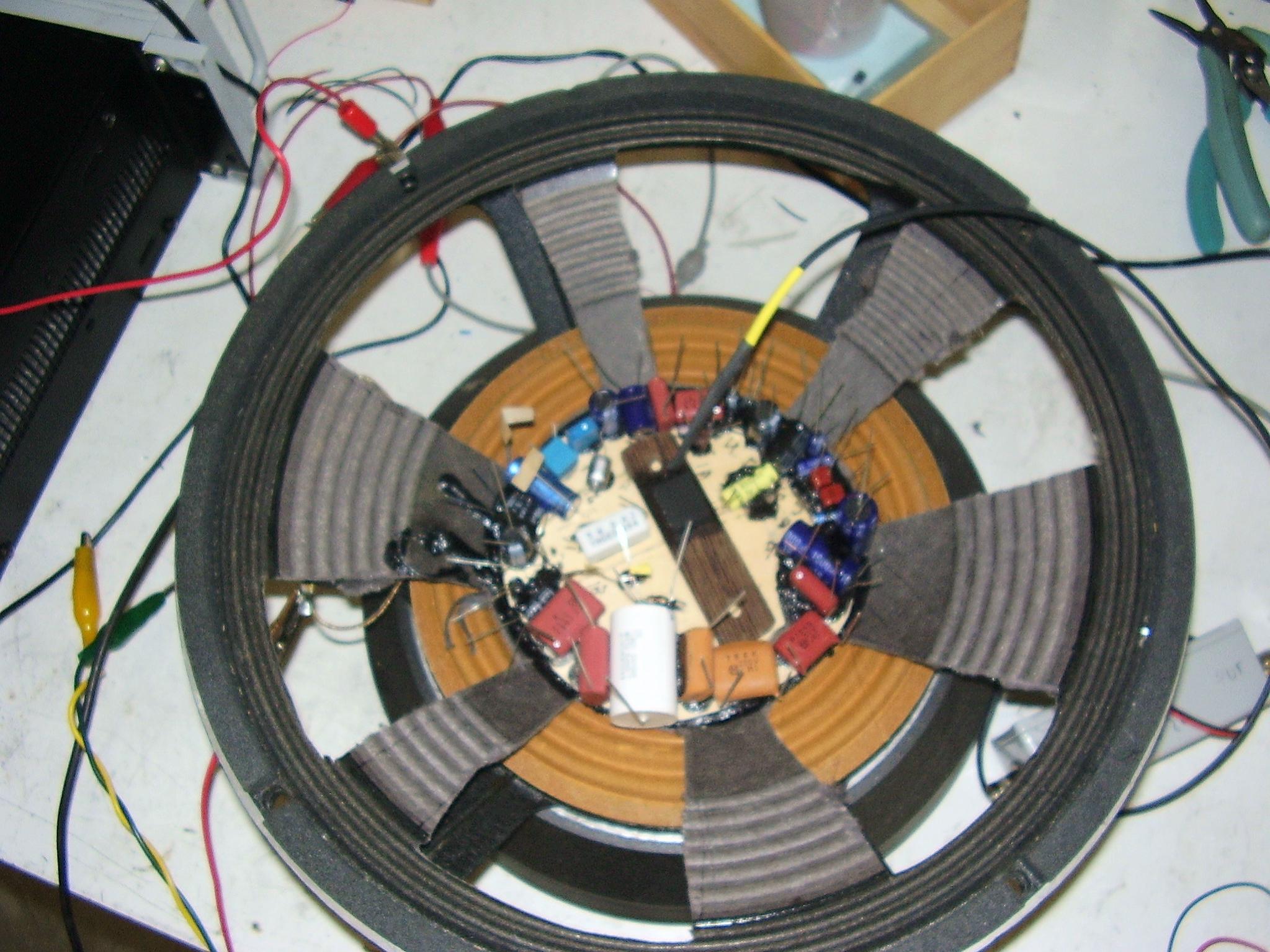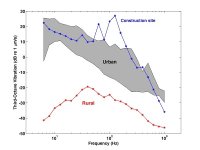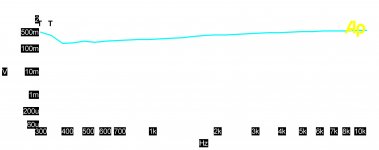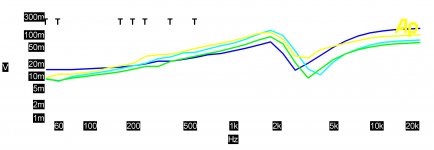It is microphonic at audio frequencies. Worse if there is DC across it. You don't need to hit it with a hammer. A shaker table will show it well. As there is a baseline of at least .05G (G as in Gravity) vibration everywhere you can easily see how much of an issue any part will be in a given circuit. Not surprisingly the larger and bulkier capacitors usually have less of an issue.
Attached are some results from ceramic capacitors and a picture of the test device. Note where the resonances occur, prime audio frequencies.
Excitation was as I recall a 9V battery with a 10K series resistor. Note this is different than the piezoelectric effect.
Notice that this pitiful/shameful 😱 (pick one) contraption

improperly elevated to "shake table" status 🙄 places "measured" parts straight in the electromagnetic flux of the voice coil, less than 1 inch away.
How can anybody measure any voltage across "tested" parts separate from the electromagnetically induced one (which must be orders of magnitude higher) and consider them meaningful of *anything* is beyond me. 😕
Last edited:
Here are plots of other capacitors and the shorted lead baseline.
The green - light blue is a mylar cap in two mounting directions, the other an electrolytic in both positions. The bottom is the baseline.
But as this is beyond you, just ignore it.
The green - light blue is a mylar cap in two mounting directions, the other an electrolytic in both positions. The bottom is the baseline.
But as this is beyond you, just ignore it.
Attachments
Last edited:
When it comes to asymmetrical passive devices, always conical inductors come to my mind. To get the up to 40GHz SRF (for a 1uH inductance, the equivalent of 1.6E-5pF in parallel) they have to be connected in a very specific way (peak at the "hot" point).
Nothing to do with audio, of course.
Nothing to do with audio, of course.
As there is a baseline of at least .05G (G as in Gravity) vibration everywhere you can easily see how much of an issue any part will be in a given circuit.
I'm shocked that having an anechoic basement you would tolerate so much seismic noise. This is from the Acoustical Society of America the number at 100Hz roughly translates to 6.4e-6 G for a rural area. Those guys at LIGO better give up they need to do e-23 G before they can detect anything more than an extinction event reliably.
Attachments
and different resistor don't have different parameters?? ie sound ?
In your view of hifi, which appears to be dominated by legacy gear and gear constructed in accordance with legacy traditions, the failings of legacy technology may lead to audible failures to reproduce audio signals with sufficient accuracy.
In other people's view of hifi, which is based on modern gear with standard or better technical performance, the effects of many decades of additional technical refinements have been among other things made it highly probable that audio signals are reproduced with sufficient accuracy.
Therefore, you may continue to bedeviled with the effects outdated technology.
It is to say the very least very insulting for someone to sit in judgement of people just because they disagree with their choices to exploit modern technology.
Based on modern carefully controlled listening tests it is also well known that the performance and sensitivity of much modern audio measurement gear vastly exceeds that which can be reliably detected by the human ear.
Thus, just because a fault can still be measured at some vanishing residual value does not mean that is it is heard by anybody or everybody.
I'm shocked that having an anechoic basement you would tolerate so much seismic noise. This is from the Acoustical Society of America the number at 100Hz roughly translates to 6.4e-6 G for a rural area. Those guys at LIGO better give up they need to do e-23 G before they can detect anything more than an extinction event reliably.
The tests were done in my shop. The .05G I get from my friends who do such work for among others the semiconductor Fabs! My shop is in the city and when trucks go by I get well above .05G (Your table is 1/3 octave bandwidth mine is 20-20K. So 10e-6 will go up to 10e-3, we are not too far apart!)
But attached is the baseline calibration of my shaker. it is 1V/G
My conclusion was do not put your phono preamp on top of your loudspeakers.
Again measurements not listening tests. The closest listening claims have been to glue the capacitors to the circuit card makes things sound better. Not really a tight claim to these results.
Attachments
Last edited:
The tests were done in my shop. The .05G I get from my friends who do such work for among others the semiconductor Fabs!
We have no trouble measuring 150uG/rt-Hz noise spec on accelerometers in the lab with little caution. You need to take care not to mix up total integrated and spot noise numbers.
We have no trouble measuring 150uG/rt-Hz noise spec on accelerometers in the lab with little caution. You need to take care not to mix up total integrated and spot noise numbers.
150 uG I believe is .15mG/rt Hz so at a BW of 10,000 Hz that would be 15mG or .015 G.
So as we are coming to agreement, I will bet when you measure for noise floor you orient the devices under test for minimum external forces. Probably don't even tightly couple them to the counter.
150 uG I believe is .15mG/rt Hz so at a BW of 10,000 Hz that would be 15mG or .015 G.
So as we are coming to agreement, I will bet when you measure for noise floor you orient the devices under test for minimum external forces. Probably don't even tightly couple them to the counter.
No one I ever talked to mentioned this as a problem at all but I know who to ask.
No one I ever talked to mentioned this as a problem at all but I know who to ask.
Or you could glue one to a bench and see what it said! While you are at it why don't you glue a chip capacitor to it and make some measurements! 🙂
If anyone cares I did test an X7R ceramic and not very surprising it was bad. However not bad enough to work as a vibration sensor on my engraving machine to give me a signal when it finished. Ended up using an actual microphone.
The subjective descriptions in the SAS Audio Labs, amplifier preamps, resistor comparisons: article are pointing to signal modulated noise.......As to resistor directionality even on AC signals it does not show up as distortion instead it may seem to be an increase in signal modulated noise. Not really an unknown phenomena. Just very obscure.
Dan.
The subjective descriptions in the SAS Audio Labs, amplifier preamps, resistor comparisons: article are pointing to signal modulated noise.
Dan.
Really? Even the few micro-volts out of a MC cart? You guys need some better material.
Ed - Your hypotheses are getting close to requiring violation of superposition.
What are the typical current levels into the 100R load?.Really? Even the few micro-volts out of a MC cart? You guys need some better material.
Dan.
Really? Even the few micro-volts out of a MC cart? You guys need some better material.
Ed - Your hypotheses are getting close to requiring violation of superposition.
Actually not. It is superposition that explains much of the issue. If I have a source of energy that flows through a circuit element then all of the energy needs to be accounted for. If I source a known AC voltage into a component and see a loss of the fundamental, but the voltage out remains the same there is no violation of superposition. When the voltage out does not contain harmonics of the fundamental there is something interesting going on.
This issue has been noted by many going back to the vacuum tube days. This has been labeled "Excess Noise." Or are you going to argue the noise energy is generated without additional loss of the signal energy? That would be a violation of superposition.
(I suspect strongly you know not to confuse this with thermocouple issues.)
Now the excess noise is very small, but unlike harmonic distortion it is not as easily masked in the hearing process. Now good quality carbon comp resistors may produce 3uV per 1 VRMS of signal. Bad carbon film resistors actually can do more! Still looking at what I need to do a set of measurements. But the hearing model leads me to form an OPINION that energy around 100-150 hertz will not mask energy -60 db down at 3,000-6,000 hertz.
I should point out the new excess energy at higher frequencies may actually mask some of the information content that should be there.
Last edited:
Dario, you were very brave pointing out your listening preferences with Dale resistors. Don't let the critics get you down! '-)
Thanks Mr. Curl 🙂
Don't worry, I know what I hear and who actually tries too.. 😉
BTW SY is right about the risk of different batches of parts with different (possible) orientation of markings.
Box film caps are an example, on Wimas it can be more reliable using the point where plastic is injected, on Vishay/Roederstein by the plastic relief ERO logo.
I guess that resistors are (possibly) a bit different since so far orientation has been pretty consistent in all the parts I've tested, to the point that orientation is consistent among different models/series from same (original) manifacturer.
To measurements guys:
is there a measure that can discern between supertight bass and a softer,rounder bass?
I would love to measure a resistor in both directions, the main parameter is bass quality.
Those guys at LIGO better give up they need to do e-23 G before they can detect anything more than an extinction event reliably.
The gravity wave experiments are quite mind boggling in the precision they need. The LISA project also seems quite astoundingly bonkers in that respect.
To measurements guys:
is there a measure that can discern between supertight bass and a softer,rounder bass?
I would love to measure a resistor in both directions, the main parameter is bass quality.
Well can you explain the difference in any way that other people can understand what you mean?
Well can you explain the difference in any way that other people can understand what you mean?
How can I differentiate two musical signals with bass notes where the main difference is the quality of the bass (tight and dry Vs round and soft)?
Maybe the problem is my english, otherwise can you tell me what is not clear in my sentence?
Thanks in advance 🙂
- Status
- Not open for further replies.
- Home
- Member Areas
- The Lounge
- Resistor Sound Quality?



